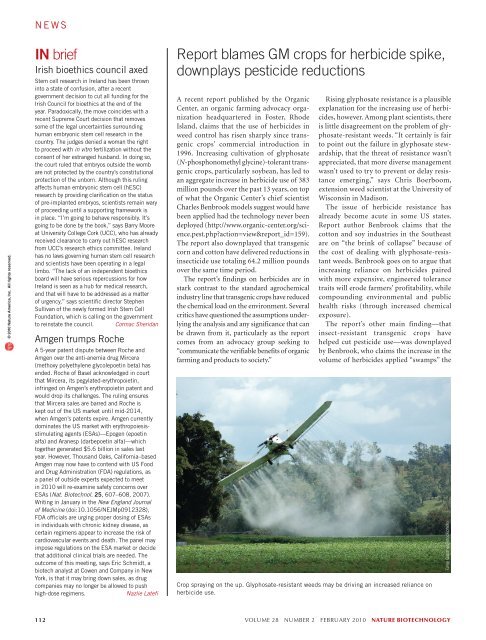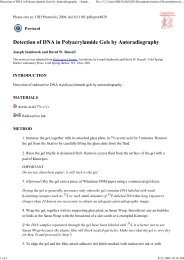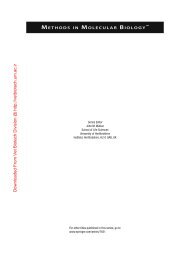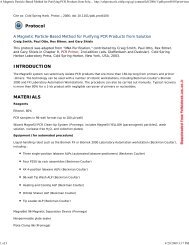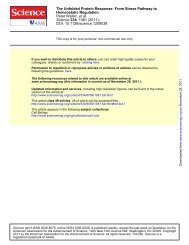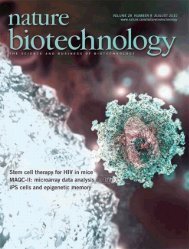© 2010 Nature America, Inc. All rights reserved.NEWSin briefIrish bioethics council axedStem cell research in Ireland has been throwninto a state of confusion, after a recentgovernment decision to cut all funding for theIrish Council for bioethics at the end of theyear. Paradoxically, the move coincides with arecent Supreme Court decision that removessome of the legal uncertainties surroundinghuman embryonic stem cell research in thecountry. The judges denied a woman the rightto proceed with in vitro fertilization without theconsent of her estranged husband. In doing so,the court ruled that embryos outside the wombare not protected by the country’s constitutionalprotection of the unborn. Although this rulingaffects human embryonic stem cell (hESC)research by providing clarification on the statusof pre-implanted embryos, scientists remain waryof proceeding until a supporting framework isin place. “I’m going to behave responsibly. It’sgoing to be done by the book,” says Barry Mooreat University College Cork (UCC), who has alreadyreceived clearance to carry out hESC researchfrom UCC’s research ethics committee. Irelandhas no laws governing human stem cell researchand scientists have been operating in a legallimbo. “The lack of an independent bioethicsboard will have serious repercussions for howIreland is seen as a hub for medical research,and that will have to be addressed as a matterof urgency,” says scientific director StephenSullivan of the newly formed Irish Stem CellFoundation, which is calling on the governmentto reinstate the council. Cormac SheridanAmgen trumps RocheA 5-year patent dispute between Roche andAmgen over the anti-anemia drug Mircera(methoxy polyethylene glycolepoetin beta) hasended. Roche of Basel acknowledged in courtthat Mircera, its pegylated-erythropoietin,infringed on Amgen’s erythropoietin patent andwould drop its challenges. The ruling ensuresthat Mircera sales are barred and Roche iskept out of the US market until mid-2014,when Amgen’s patents expire. Amgen currentlydominates the US market with erythropoiesisstimulatingagents (ESAs)—Epogen (epoetinalfa) and Aranesp (darbepoetin alfa)—whichtogether generated $5.6 billion in sales lastyear. However, Thousand Oaks, California–basedAmgen may now have to contend with US Foodand Drug Administration (FDA) regulations, asa panel of outside experts expected to meetin 2010 will re-examine safety concerns overESAs (Nat. Biotechnol. 25, 607–608, 2007).Writing in January in the New England Journalof Medicine (doi:10.1056/NEJMp0912328),FDA officials are urging proper dosing of ESAsin individuals with chronic kidney disease, ascertain regimens appear to increase the risk ofcardiovascular events and death. The panel mayimpose regulations on the ESA market or decidethat additional clinical trials are needed. Theoutcome of this meeting, says Eric Schmidt, abiotech analyst at Cowen and Company in NewYork, is that it may bring down sales, as drugcompanies may no longer be allowed to pushhigh-dose regimens.Nazlie LatefiReport blames GM crops for herbicide spike,downplays pesticide reductionsA recent report published by the OrganicCenter, an organic farming advocacy organizationheadquartered in Foster, RhodeIsland, claims that the use of herbicides inweed control has risen sharply since transgeniccrops’ commercial introduction in1996. Increasing cultivation of glyphosate(N-phosphonomethyl glycine)-tolerant transgeniccrops, particularly soybean, has led toan aggregate increase in herbicide use of 383million pounds over the past 13 years, on topof what the Organic Center’s chief scientistCharles Benbrook models suggest would havebeen applied had the technology never beendeployed (http://www.organic-center.org/science.pest.php?action=view&report_id=159).The report also downplayed that transgeniccorn and cotton have delivered reductions ininsecticide use totaling 64.2 million poundsover the same time period.The report’s findings on herbicides are instark contrast to the standard agrochemicalindustry line that transgenic crops have reducedthe chemical load on the environment. Severalcritics have questioned the assumptions underlyingthe analysis and any significance that canbe drawn from it, particularly as the reportcomes from an advocacy group seeking to“communicate the verifiable benefits of organicfarming and products to society.”Rising glyphosate resistance is a plausibleexplanation for the increasing use of herbicides,however. Among plant scientists, thereis little disagreement on the problem of glyphosate-resistantweeds. “It certainly is fairto point out the failure in glyphosate stewardship,that the threat of resistance wasn’tappreciated, that more diverse managementwasn’t used to try to prevent or delay resistanceemerging,” says Chris Boerboom,extension weed scientist at the University ofWisconsin in Madison.The issue of herbicide resistance hasalready become acute in some US states.Report author Benbrook claims that thecotton and soy industries in the Southeastare on “the brink of collapse” because ofthe cost of dealing with glyphosate-resistantweeds. Benbrook goes on to argue thatincreasing reliance on herbicides pairedwith more expensive, engineered tolerancetraits will erode farmers’ profitability, whilecompounding environmental and publichealth risks (through increased chemicalexposure).The report’s other main finding—thatinsect-resistant transgenic crops havehelped cut pesticide use—was downplayedby Benbrook, who claims the increase in thevolume of herbicides applied “swamps” theCrop spraying on the up. Glyphosate-resistant weeds may be driving an increased reliance onherbicide use.Greg Gardnes/istockphoto112 volume 28 number 2 february 2010 nature biotechnology
news© 2010 Nature America, Inc. All rights reserved.benefits of decreased insecticide use attributableto corn and cotton expressing genes thatencode one or more Bacillus thuringiensis (Bt)insect toxins. Bt crops could have a brighterfuture than herbicide-resistant transgenicvarieties, the report states, “but if, and onlyif, [insect] resistance is prevented.”The report is based on extrapolations ofpesticide use survey data compiled by theUS Department of Agriculture’s (USDA)National Agricultural Statistics Service(NASS). Benbrook relies on annual traitacreage data compiled by St. Louis–basedMonsanto to disaggregate transgenic cropsfrom the total crop acreage. However, noNASS data on corn or soy are available for2007 or 2008, years for which Benbrookposits unusually large pesticide increasesof 20% and 27%, respectively. The mainuncertainties stem from gaps in NASS data,which, since 2001, have only been gatheredintermittently, and from that data’s failure todistinguish between pesticide use on transgeniccrop varieties and on their conventionalcounterparts.Benbrook postulates the emergence of glyphosateresistance has fueled a sharp upswingin the use of other herbicides on glyphosatetolerantcrops, whereas levels of herbicide usedon conventional crops have fallen becauseof ongoing improvements in potency. ButJanet Carpenter, formerly of the Washington,DC–based US National Center for Food andAgricultural Policy and now an independentagricultural biotech consultant, disagrees.“That’s all extrapolation,” she says. “The bottomline is we don’t know what has happenedto pesticide use in the last couple of years.”Benbrook says that additional data fromfuture surveys can be factored into his modelwhen it becomes available. “The valid criticism—orvalid question—is these are allaverage numbers,” he says. “I would place afair amount of confidence in these averagesas a reflection of what’s going on out there.”In a published critique of the report,Dorchester, UK–based consultancy PGEconomics argues that Benbrook overestimatesherbicide application rates for biotechcrops and underestimates them for conventionalcrops (http://www.pgeconomics.co.uk/pdf/OCreportcritiqueNov2009.pdf). It citesa new study from the US Geological Survey,which found that concentrations of severalmajor pesticides either declined or remainedconstant in US corn belt rivers and streamsduring 1996–2006 (http://pubs.usgs.gov/sir/2009/5132/). However, the study perioddoes not include the two most recent years,during which Benbrook claims the greatestincrease in herbicide use has occurred. PGEconomics, which also published a lengthystudy on the global socioeconomic andenvironmental impacts of transgenic cropsin May last year, has drawn on two sources:pesticide use data from a commercial source,DMR Kynetec, of St. Louis, which Benbrooksays is in general agreement with his ownfindings; and what he describes as ‘faulty’simulation data generated by the WashingtonDC–based National Center for Food andAgricultural Policy, based on exercises runwith university extension weed scientists.“It’s impossible to reconcile their estimateswith the NASS data,” Benbrook says.In the meantime, several scientists havevoiced support for the general thrust of thestudy. “There’s nothing surprising there,”says Matt Liebman, who holds the H.A.Wallace chair for Sustainable Agriculture atIowa State University in Ames. Dealing withglyphosate-resistant weeds will require alterationsin cropping systems that rely solelyon the marriage of the herbicide-tolerancetrait and the associated herbicide to controlweeds. Widespread convergence on a narrowrange of options, such as the rotationof glyphosate-resistant corn and glyphosateresistantsoybean, has been a significant factor,says Liebman. “You have good conditionsfor rapid selection of herbicide resistance.”Monsanto and its competitors are respondingto the problem by offering farmers subsidiesto include third-party herbicides intheir weed control systems. They are alsostacking additional tolerance traits that canbe paired with other herbicides, such asdicamba (3,6-dichloro-2-methoxybenzoicacid), glufosinate (phosphinothricin) and2,4-d (dichlorophenoxyacetic acid). Externalfactors have hampered progress, however.“The biggest contributor to weed resistancehas been the European Union’s slow approvalprocess for new biotech-enhanced seeds.After many years of delays, the EU finallygranted approval of Liberty Link [phosphinothricin-acetyltransferase]soybeans, whichare resistant to a different active ingredient[l-phosphinothricin],” says Bob Callanan,communications director of the AmericanSoybean Association, located in St. Louis.Critics argue that more diversifiedapproaches will be needed, such as alternativecrop rotations, novel herbicides—it’s20 years since a new mechanism of actionwas commercialized, notes Boerboom—andalternative weed control methods. “If youwant to keep this tool available and effectivethere has to be some way, short of fallowinga field, of delaying the developmentof resistant weeds,” says Robert Kremer, ofthe USDA’s Agricultural Research Service atColumbia, Missouri. The market dominanceof transgenic crop varieties limits some ofthe options, however. “It’s very difficult togo and find nontransgenic soybean,” he says.“Conventional corn rotated with RoundupReady [glyphosate-resistant] soybeans wouldbe very logical,” says Boerboom. “We have anexcellent selection of conventional herbicideswe can use in corn.”That Monsanto’s Roundup Ready croppingsystem has been a major hit with farmersis not in dispute. “The simplicity, the highefficacy and the perceived low cost have beenvery attractive,” says Liebman. In this respect,even Benbrook agrees: “The weed managementsystems that Roundup Ready [crops]replaced were unforgiving and required ahigh level of skill and management to get thebenefits out of them,” he says. What’s more,glyphosate, which inhibits 5-enolpyruvylshikimicacid-3-phosphate synthase, a plantenzyme involved in amino acid biosynthesis(the engineered trait comprises a bacterialform of the enzyme, which is unaffected),has a relatively benign environmental profilein comparison with many other herbicides.Moreover, it has allowed many crop growersto shift to no-till agriculture, which reducesfossil fuel inputs.The problems farmers are encounteringnow are not new. “The selection forglyphosate resistance is not unique. We’veselected for a whole lot of other herbicidefamilies as well,” says Aaron Hager, weedscience extension specialist at the Universityof Illinois at Urbana-Champaign, Illinois.“There’s a plant somewhere in the worldthat’s resistant to an herbicide that hasn’teven been discovered yet. That’s how selectionoccurs.”As glyphosate has played a central role inUS crop production over the past decade, itcan be argued the technology has become avictim of its own success. For many farmers,weed control will, however, soon becomemore complex. Some of the alternativesoffer less favorable environmental profiles.Dicamba, a synthetic auxin or plant hormone,can drift off-site and interfere withflowering plants, for example. “There will beobjections raised to it by the environmentalcommunity because of nontarget effects,”says Liebman.Nevertheless, US agriculture is not facing adoomsday scenario, according to Boerboom.“I don’t think it’s like we’re going into somedark age of chemical use on the landscape,”he says. But a new phase in the moleculararms race between biotech and nature is gettingunderway.Cormac Sheridan Dublinnature biotechnology volume 28 number 2 february 2010 113
- Page 3 and 4: volume 28 number 2 february 2010COM
- Page 5 and 6: in this issue© 2010 Nature America
- Page 7 and 8: © 2010 Nature America, Inc. All ri
- Page 10 and 11: NEWS© 2010 Nature America, Inc. Al
- Page 12 and 13: NEWS© 2010 Nature America, Inc. Al
- Page 14 and 15: NEWS© 2010 Nature America, Inc. Al
- Page 18 and 19: © 2010 Nature America, Inc. All ri
- Page 20 and 21: © 2010 Nature America, Inc. All ri
- Page 22 and 23: NEWS feature© 2010 Nature America,
- Page 24 and 25: uilding a businessComing to termsDa
- Page 26 and 27: uilding a business© 2010 Nature Am
- Page 28 and 29: correspondence© 2010 Nature Americ
- Page 30 and 31: correspondence© 2010 Nature Americ
- Page 32 and 33: correspondence© 2010 Nature Americ
- Page 34 and 35: correspondence© 2010 Nature Americ
- Page 36 and 37: case studyNever againcommentaryChri
- Page 38 and 39: COMMENTARY© 2010 Nature America, I
- Page 40 and 41: COMMENTARY© 2010 Nature America, I
- Page 42 and 43: patents© 2010 Nature America, Inc.
- Page 44 and 45: patents© 2010 Nature America, Inc.
- Page 46 and 47: news and viewsChIPs and regulatory
- Page 48 and 49: news and viewsFrom genomics to crop
- Page 50 and 51: news and views© 2010 Nature Americ
- Page 52 and 53: news and views© 2010 Nature Americ
- Page 54 and 55: e s o u r c eRational association o
- Page 56 and 57: e s o u r c e© 2010 Nature America
- Page 58 and 59: e s o u r c e© 2010 Nature America
- Page 60 and 61: e s o u r c e© 2010 Nature America
- Page 62 and 63: © 2010 Nature America, Inc. All ri
- Page 64 and 65: B r i e f c o m m u n i c at i o n
- Page 66 and 67:
i e f c o m m u n i c at i o n sAUT
- Page 68 and 69:
lettersa1.5 kb hVPrIntron 112.5 kbA
- Page 70 and 71:
letters© 2010 Nature America, Inc.
- Page 72 and 73:
letters© 2010 Nature America, Inc.
- Page 74 and 75:
l e t t e r sReal-time imaging of h
- Page 76 and 77:
l e t t e r sFigure 2 Time-lapse li
- Page 78 and 79:
l e t t e r s© 2010 Nature America
- Page 80 and 81:
l e t t e r sRational design of cat
- Page 82 and 83:
l e t t e r s© 2010 Nature America
- Page 84 and 85:
l e t t e r s© 2010 Nature America
- Page 86 and 87:
sample fluorescence was measured as
- Page 88 and 89:
careers and recruitmentFourth quart


